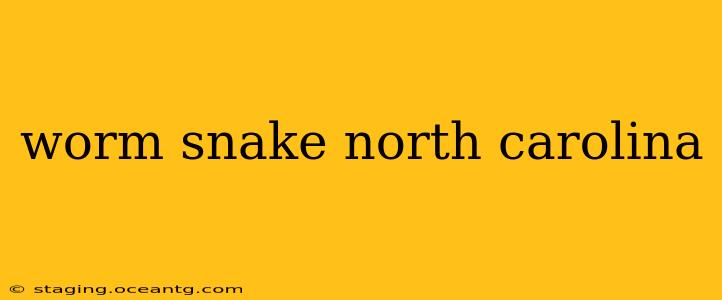North Carolina boasts a diverse ecosystem, and its reptile population is no exception. Among its slithering inhabitants are several species of worm snakes, often mistaken for earthworms due to their slender bodies and secretive nature. This comprehensive guide delves into the world of North Carolina's worm snakes, exploring their identification, habitat, behavior, and conservation status.
What Kinds of Worm Snakes Live in North Carolina?
North Carolina is home to two primary species of worm snakes: the Eastern Worm Snake (Carphophis amoenus) and the Carolina Worm Snake (Carphophis amoenus helenae). While both are incredibly similar in appearance, subtle differences exist. The Eastern Worm Snake has a broader geographic range, extending beyond North Carolina, while the Carolina Worm Snake is more localized. Identifying them to species level often requires close examination by a herpetologist. Key distinguishing factors can include subtle variations in scale counts and coloration. For the average observer, focusing on general worm snake characteristics is more practical.
How Can I Identify a Worm Snake?
Worm snakes are easily distinguished from other snakes by their unique characteristics:
- Size and Shape: They are small, typically reaching lengths of 8-14 inches. Their bodies are extremely slender and cylindrical, resembling earthworms.
- Coloration: Generally, they display a dark brown or black dorsal surface, with a lighter, pinkish-tan belly. Some may exhibit subtle reddish or bronze hues. The coloration can vary slightly between individuals and subspecies.
- Head Shape: Their head is small and indistinct from the neck, lacking the pronounced head shape seen in many other snake species.
- Scales: They possess smooth, glossy scales.
- Behavior: They are secretive, fossorial (burrowing) snakes, rarely seen above ground.
Where Do Worm Snakes Live in North Carolina?
Worm snakes prefer moist, loose soil environments. In North Carolina, you're likely to find them in:
- Forests: Both deciduous and mixed forests provide ideal habitats.
- Fields: Areas with rich topsoil and ample leaf litter.
- Gardens: Sometimes they may be found in gardens with undisturbed soil.
- Under Rocks and Logs: These provide shelter and protection.
They are rarely found in open, sunny areas.
What Do Worm Snakes Eat?
Worm snakes are primarily insectivores, feeding on a variety of invertebrates including:
- Ants: A significant portion of their diet.
- Beetles: Larvae and adult beetles.
- Insect Larvae: Various insect larvae dwelling in the soil.
- Earthworms: While their name suggests a primary diet of earthworms, ants and other insects tend to be more significant food sources.
Are Worm Snakes Poisonous or Venomous?
No, worm snakes are not poisonous or venomous. They are completely harmless to humans. Their small size and secretive nature mean encounters are rare, and even when encountered, they pose no threat.
What is the Conservation Status of Worm Snakes in North Carolina?
While not currently listed as threatened or endangered, habitat loss due to deforestation and urbanization poses a potential threat to worm snake populations. Protecting and preserving their habitat is crucial for the long-term survival of these fascinating creatures.
How Can I Help Protect Worm Snakes?
By practicing responsible land management, you can contribute to the conservation of worm snakes:
- Avoid disturbing their habitat: Be mindful when gardening or undertaking any outdoor activities in areas where worm snakes may live.
- Support conservation efforts: Support organizations dedicated to protecting natural habitats and biodiversity.
- Educate others: Spread awareness about worm snakes and the importance of their conservation.
This guide provides a comprehensive overview of worm snakes in North Carolina. Remember, if you encounter a worm snake, admire it from a distance and leave it undisturbed in its natural environment. Their secretive nature means sightings are special, and they play a vital role in the ecosystem.
